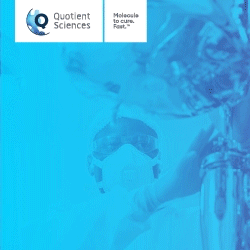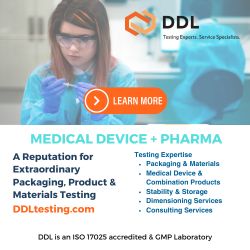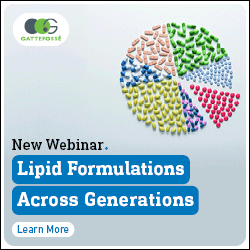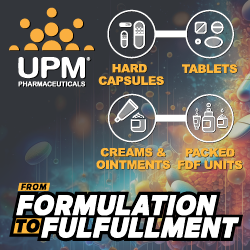Issue:January/February 2025
DRUG DEVELOPMENT - What is Formulation Development & Why is it Important?
INTRODUCTION
Formulation Development is fundamentally about understanding how a drug’s properties, such as chemical structure, solubility, stability, and bioavailability, change as a result of how it is formulated. The process, although often overshadowed by the clinical aspects of drug development, plays a critical role in the development and manufacture of stable, safe, and effective medications. It is, in essence, where science meets practicality. This process involves a delicate balance of scientific rigor and practical application, and not only requires a profound understanding of the drug’s properties, but also the ability to navigate the many challenges of delivering the drug in an effective and patient-centric manner.
WHEN DOES FORMULATION DEVELOPMENT TAKE PLACE?
Biopharmaceutical formulation development can be applied in tandem with Cell Line Development, later once the manufacturing process has been developed, or as part of clinical life-cycle product management. However, in a constantly evolving discovery and development landscape, there is a continual push to bring key activities forward, do more with less, and progress multiple candidates in parallel as far as possible. While there are clearly some aspects that cannot be performed at an earlier stage (eg, activities that require information derived from Phase 1/2 clinical trials used to support dosage for future clinical phases), there are several aspects that can be considered early on, and that should form part of lead candidate selection criteria. Therefore, formulation development represents a spectrum of activities spanning from late discovery/early development, all the way through to Phase 3.
A PROACTIVE APPROACH TO FORMULATION DEVELOPMENT
Effective drug formulation hinges on early detection of potential drug instabilities. At Abzena, we apply a series of rigorous stress tests designed to assess how well a drug will hold up during the manufacturing process, as well as its stability on long-term storage. Strategic decision-making, informed by the outcomes of these tests, guides developers in refining the formulation process. By proactively identifying formulation challenges early, potential setbacks in later stages of development can be avoided, which is essential for efficient and successful drug development and production.
A Best-Practice Formulation Strategy
The formulation of a biologic drug is a complex process that involves multiple stages, each playing a crucial role in ensuring the safety, efficacy, and manufacturability of the final product. This journey begins with a thorough understanding of the drug’s physicochemical properties. Subsequent stages involve developing and refining the formulation to address any potential challenges, optimizing it for manufacturing, and conducting extensive stability testing.
The stages of biopharmaceutical drug formulation from initial analysis to final optimization include:
Stage 1: Developability assessment and manufacturing stress studies.
Stage 2: Pre-formulation.
Stage 3: Pre-manufacturing optimization.
Stage 4: Extended stability testing.
Stage 5: Freeze-thaw stability.
It is the first stage of formulation development that we will focus on for the remainder of this article to highlight the importance of this stage.
FORMULATION & DEVELOPABILITY
What is Developability?
Developability, simply put, is an overarching concept that describes the properties that predict the ease and likelihood with which a candidate molecule can be developed into a safe, effective, manufacturable, and marketable drug.
The Role of Developability Assessments
Performing an assessment to understand these developability properties is pivotal in the early stages of drug development as this serves not only to assess the viability of any given lead candidate but also, by utilizing a battery of assays early on, allows effective triaging and candidate selection from a larger panel of leads. These assessments aim to provide a comprehensive evaluation of a drug candidate’s intrinsic characteristics ensuring they are amenable to development, scale-up and commercialization, and by focusing on critical biophysical properties, help identify potential roadblocks that could impede a drug’s path from laboratory to market.
One of the key areas of focus for developability assessment is stability as this directly impacts a biological drug’s effectiveness and safety over time. To be viable as a potential candidate, a protein must maintain its colloidal stability, chemical integrity, and therapeutic potency not just during the manufacturing process and in final drug product, but also through long-term storage, shipping, and in-use handling. With a preference that molecules have a solution stability of at least 2 years, obtaining real-time stability data is extremely time-consuming. Consequently, at early stages of formulation development, properties are scrutinized through a series of accelerated stability stress studies that aim to mimic and predict how the drug will behave in real-world scenarios, ensuring that any potential issues can be addressed before significant investments are made.
Example studies may include:
- Low pH stress study – designed to mimic conditions encountered during the viral inactivation step as well as being a common manufacturing step to elute off protein A.
- Freeze thaw study – to test intrinsic stability towards freezing and thawing conditions which the drug may be subjected to if the final presentation is a frozen liquid.
- Thermal stress study – where a sample is stressed at a higher temp to mimic temperature excursions that can happen for example during transit where a cold-chain cannot be maintained.
From a holistic drug development perspective, the value of assessing developability is immeasurable. Developers can not only identify viable candidates by predicting potential manufacturing and scalability challenges early, they can also devise strategies to mitigate any downstream development risks and inform the final form of drug product for clinical evaluation. This reduces the likelihood of late-stage failures and significantly cuts down on development costs and time. As such, developability assessments represent a strategic tool that guides the decision-making process, ensuring that only the most promising drug candidates are advanced into the more costly and time-intensive phases of clinical trials. By applying these assessments, developers can prioritize and, if necessary, reallocate their resources to focus on candidates with the highest potential for success and market impact.
How to get the Most From a Developability Assessment?
Developability assessment should, at a minimum, investigate stability-associated parameters, including thermal, freeze thaw, and acidic stability. In silico evaluation may also identify additional risks, such as isomerization or deamidation sites that may require additional studies at this stage. Particular attention should be paid to risks that may lead to decreased drug potency/activity, with binding assays performed on stressed samples to understand the impact.
While these types of studies are considered fairly typical, there are nuances around how they can be performed and therefore the interpretation of the data and usefulness of information gained. As a simple example, there is a tendency for phosphate-buffered saline (PBS) to be used as the “default” buffer when screening large panels of monoclonal antibodies (mAbs) in earlier stages of discovery given the convenience of an off-the-shelf reagent. However, experience suggests PBS is not always an ideal buffer, and using it sometimes can lead to poor decision-making, especially if used at later stages of candidate selection.
One approach to enable better decision-making is to perform a limited three-buffer thermal ramping stability screen prior to stability studies, such as thermal stress and freeze thaw. In this approach, PBS (or the buffer the sample is provided in) together with a histidine pH 6 buffer containing pre-defined concentrations of NaCl or sucrose are recommended. As a starting point, this captures most elements of a “good enough” buffer. Performing a thermal ramping assessment on multiple lead candidates in these three buffers aims to ensure that, when moving into the thermal stability and freeze thaw studies, no candidate is disadvantaged simply by being in the “wrong” buffer and thereby improves likelihood of selecting the best candidate. Additional information gained at this stage can also indicate a preference for NaCl or sucrose which can, in turn, be used to influence the panel of buffers and excipients used within the broader pre-formulation study.
The three-buffer screen previously described can be modified further based upon prior studies. By way of example, if an in-silico or bench assessment has identified a potential isomerization site, then it may be desirable to modify the buffer screen by making it slightly less acidic, eg, using a histidine buffer at pH 6.5 instead of 6.
As the high pH, low pH, and aspartate isomerization stress studies are generally formulation buffer-agnostic, they can be performed without the need for the buffer screen and additionally, can provide essential information to guide and inform downstream formulation as well as process development activities. For example, the low pH study may suggest a potential issue with using a low pH hold as part of the manufacturing process and may require modifications to the process, through using either a slightly increased pH (within viral inactivation constraints) or an alternative low pH buffer. Additionally, forced degradation assessments can elucidate pH-dependent behaviors that can help determine if changing the formulation to avoid one liability may inadvertently increase the risk of a new unwanted liability. For example, whether raising the pH to avoid Asp isomerization may in turn promote additional liabilities such as Asn deamidation. Keeping a close eye on binding affinities of a candidate post-stress can also mitigate against conditions, which may appear to be stabilizing and yet in reality render the molecule less potent.
Challenges of Bringing Formulation Development Forward
Formulation development studies can typically be very material intensive, and so one of the key limitations of earlier stage testing is material availability. In this regard, expression systems have developed enormously over the last 10+ years and the ability to obtain significant quantities of material at an acceptable cost and timeframe is continually improving, thus increasing the potential to screen more candidates.
However, as discussed earlier, biologics development itself is constantly evolving, with the continual challenge being of how to do more with less. One key area of focus is how to bring high concentration studies forward so they can be performed as part of the candidate triaging. Different approaches are being explored, including using high throughput/low material requirement platforms, such as the Uncle (Unchained Labs) or Prometheus Panta (Nanotemper) to determine the diffusion interaction parameter (kD) that has been reported to be a predictor of high concentration behavior. Other surrogate assays exist, such as AC-SINS (a method that monitors antibody self-association); however, these are more typically used to understand properties such as pharmacokinetics (PK). AC-SINS is typically performed in PBS and, as with stability studies, the necessity of screening self-association behavior in more relevant formulation conditions has been recognized. One such method is PS-SINS, an optimized method that enables profiling of mAbs in several formulation conditions, including the previously unfeasible histidine formulation, and suggests that the PS-SINS profiling data (beyond the single PBS condition) provide richer and more valuable information for early-stage antibody triaging.
Risks of Not Considering Formulation Development Early On
Neglecting early stage developability assessments and pre-formulation screening can lead to significant and often avoidable challenges. Numerous case studies across the pharmaceutical industry illustrate how insufficient early testing has resulted in major setbacks, for example, drugs that appeared promising in early biological assays have faltered during Phase 2 or 3 clinical trials because issues like poor stability or instability were not addressed upfront.
The financial and operational implications of these oversights are substantial. Development delays not only lead to additional costs associated with testing and reformulation but also extend the time to market, which can have significant competitive and financial repercussions. This in turn, can damage investor confidence when projects do not progress as anticipated, affecting a company’s financial standing and its ability to secure future funding. Operationally, shifting the team’s focus from advancing the development pipeline to troubleshooting and resolving formulation or stability issues, can impact not only the drug in question but also delay development of other molecules in the pipeline.
Therefore, investing in comprehensive early stage assessments is not merely a technical necessity, but a strategic imperative that underpins the success of a company as it strives to develop new pharmaceuticals for patients in need.

Dr. Rob Holgate has over 25 years of experience in Drug Discovery and early stage Development. After earning his PhD in Molecular Medicine at UCL, he moved to The University of York as a post-doctoral researcher. He subsequently worked at Cambridge Antibody Technology before joining Antitope (now Abzena) in 2008 as a Research Manager, then leading Abzena’s Discovery and Protein Engineering group. Now, as VP of Research and Innovation, he plays a key role working with clients to understand the challenges they may face during discovery and early development to help them develop safe and effective therapies.

Dr. Nicola Watts is a Principal Scientist in the Analytics Group at Abzena and has been with the company for over 3 years. She has a background in formulation spanning 8 years, during which she has worked on numerous projects involving formulation of mAb biosimilars, formulation of GLP-1 type peptides, co-formulations, high concentration subcutaneous products, high-throughput formulation strategies utilizing liquid handling robotics, and late-stage formulation activities, such as container/device compatibility. Previous to Abzena, she worked at Intertek Melbourn focussing on inhalation therapies for the treatment of conditions such as COPD. During this role, she also investigated novel strategies aimed at the successful nebulization of biologics for inhalation administration.
Total Page Views: 7227














